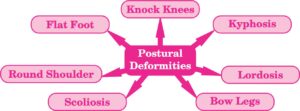2.1 Exercise Guidelines of WHO for Different Age Groups
Characteristics of Development and Exercise :
- The World Health Organization (WHO) has ranked physical inactivity as the fourth most important risk factor for mortality (6% of deaths globally).
- There are numerous chances to preserve one’s physical, mental, and social health through regular participation in sports and physical activity.
- Sports and physical exercise participation has advantages include boosting self-esteem and confidence, improving emotional regulation, lowering stress, anxiety, and depression levels, maintaining a healthy weight, fostering social connection, and achieving academic excellence.
- Regular physical activity promotes the social, emotional, and mental development of newborns, children, adolescents, and adults in addition to their physical development.
- Children should be encouraged to participate in physical activity to ensure healthy bones and muscles.
- Children and teenagers should not be allowed to sit for long periods of time watching TV, playing computer games, or traveling.
Different stages of a human life :
- Infancy (Less than 1 year)
- Toddler (1-2 years); Children 3-4 years
- Early school age (5-7 years)
- Middle school age (8-12 years)
- Early adolescence (13-17 years)
- Later adolescence (18-25 years)
- Early adulthood (25-30 years)
- Middle adulthood (30-50 years)
- Later adulthood (50 and up)

2.1.1 Recommendations for Children Under 5 Years of Age
The following guidelines are recommended for healthy children aged Under 5 years. The age group is further subdivided into three categories: less than 1 year, 1 to 2 years, and 3 to 4 years.
Age : Less than 1 year
Sedentary Behaviour : It is not permitted to be restrained for more than 1 hour at a time. Encourage sedentary reading and storytelling. Screen time is not advised.
Physical Activity : Physically active multiple times a day, including 30 minutes of belly time, through interactive floor-based play.
Sleep : 14-17 hours (0-3 months), and 12-16 hours (4-11 months) of restful sleep, which includes naps.
Age : 1-2 years
Sedentary Behaviour : Not to be restrained for more than one hour at a time or to sit for long periods of time. One-year-olds are not allowed to watch television. Sedentary screen use should be limited to one hour each day for the first two years. Encourage storytelling and reading.
Physical Activity : At least 180 minutes scattered throughout the day of a mix of active activities, including moderate to vigorous intensity physical activity.
Sleep : 11-14 hours of high-quality sleep, including naps, with regular sleep and wake-up intervals.
Age : 3-4 years
Sedentary Behaviour : Not to be restrained for more than one hour at a time or to sit for long periods of time. Sedentary screen time should be limited to no more than one hour; less is more. Promote reading and storytelling.
Physical Activity : At least 180 minutes of moderate to vigorous level physical activity dispersed throughout the day, with at least 60 minutes of moderate to vigorous intensity physical activity.
Sleep : 10-13 hours of good quality sleep, including naps, with regular sleep and wake-up periods.
Exercise Guidelines at Different Stages of Growth in Infants (Less than 1 year) :
- Infants should be given ample space and an open environment to encourage activity while minimising restrictive or sedentary behaviour, allowing them to explore their surroundings.
- Babies should be encouraged to be active at all times of the day.
- Encourage your baby to be physically active before he or she learns to crawl by reaching and gripping, tugging and pushing, and moving her or his head, body, and limbs throughout daily routines and supervised floor play.
- This includes placing the baby in the prone position for 30 minutes (tummy time).
- Playing equipment should be carefully selected and should not be too small to be ingested, have sharp edges, or be made of poisonous materials.
- Crawling and rolling should be done on a mat or sheet that is at least 7 feet by 4 feet in size.
- Encourage newborns to be as active as possible in a safe, supervised, and supportive play setting once they can move around.
- For encouragement, the child must be engaged in reading and storytelling at sedentary timing.
- 14-17 hours of good quality sleep, including naps, for babies aged 0-3 months, and 12-16 hours for babies aged 4-11 months.
Exercise Guidelines at Different Stages of Growth in Toddlers (1-2 years of age) :
- The kid should not be engaged in any sedentary activity that lasts longer than an hour during this time, including being strapped to a caregiver’s back, in a high chair, or restricted in a pram or stroller.
- Toddlers should be encouraged to engage in basic physical activities like walking, running, jumping, catching, throwing, leaping, etc. Once they have mastered sitting and standing
- Sedentary screen usage, such as playing computer games, watching TV, or watching videos is not advised for this group.
- Reading and storytelling sessions shouldn’t last longer than an hour.
- Toddlers should obtain 11 to 14 hours of sleep every night, including naps, with consistent bedtimes and wakeup times.
Exercise Guidelines at Different Stages of Growth in Children 3-4 years :
- Children should engage in physical exercise for at least 180 minutes, of which at least one hour should be spent engaging in activities of a moderate to intense level.
- Either inside or outside, this should be spread out throughout the day.
- We can include both low-intensity activities like standing up, moving around, rolling around, and playing in the 180 minutes of physical activity, as well as higher-intensity ones like skipping, hopping, sprinting, and leaping.
- For this age group, active play is the ideal approach to get moving, such as utilising a climbing frame, riding a bike, playing in the water, chasing games, and ball games.
- A maximum of an hour should be spent sitting down, and reading and storytelling should be encouraged during this time.
- It is advised to get between 10 and 13 hours of good sleep per night, including naps, with consistent bedtimes and wakeup timings.
Exercise have Numerous Physical Benefits on Children :
- Good motor development
- Posture alignment and good body image, improves physical appearance
- Reduces fatigue
- Increases alertness
- Weight management, prevents obesity
- Increases bone density and prevent from osteoarthritis
- Tolerance of hot and cold climatic conditions.
- Improves muscle Tone and minimizes the risk of injuries
- Improves neuromuscular co-ordination.
Exercise have Numerous Physiological Benefits on Children :
- Stronger immunity, reduces the chances of diseases
- Increase lactic acid tolerance
- Increase in size of fibres and connective tissues
- More blood supply
- Density of blood vessels increases
- Myoglobin increases.
- Oxidation of carbohydrate increases
- Improves muscle composition
2.1.2 Children and Youth 5-17 Years
Exercise Guidelines in Children and Youth 5-17 Years :
- The frequency, duration, and intensity of the activities should be increased gradually. For instance, start the session with simple exercises and work your way up to more complicated ones.
- This age group goes through several growth stages, and at each level, the activities alter.
- The main goals of activities for this age group are to increase bone health, cardiovascular and metabolic health biomarkers, cardiorespiratory and muscular fitness, and anxiety and depressive symptom reduction.
Intensity : Moderate to Vigorous.
Volume/Duration : A minimum of one hour every day; exercising for longer than 60 minutes will have additional health advantages.
Frequency : One session of 1 hour or two sessions of 30 minutes each.
Types of Activities : Aerobic activities, essential muscle-building exercises, Primary activities (Jumping, running, throwing, turning twisting etc.)
Benefits : • In addition to maintaining a healthy body composition, regular exercise helps to develop and maintain the neuromuscular, cardiovascular, and respiratory systems as well as the musculoskeletal, cardiovascular, and respiratory systems.
- Physical activity also promotes academic success, results in good behaviour (avoidance of tobacco, alcohol, and narcotics), and develops sociological and psychological components (control over emotions, anxiety, depression, and stress management).
Activities : Games, sports, recreation, physical education, spontaneous to organised activities with or within the family, school, and community.
2.1.3 Adults 18-64 Years
Exercise Guidelines in Adults 18-64 Years :
Intensity : Moderate to Vigorous.
Types of Activities : Strengthening your muscles and engaging in aerobic exercise
Aerobic activities : 75 to 150 minutes of vigorous activity or 150 to 300 minutes of moderate activity per week; each session of aerobic exercise should last at least 10 minutes.
Muscle strengthening activities : Heavy muscle-intensive activities on two or more days per week.
Benefits : • Regular physical activity helps to lower the risk of all causes of death, including heart disease, high blood pressure, stroke and Type 2 diabetes.
- It reduces the likelihood of Non-communicable Diseases and depression.
- Develop a higher level of cardiorespiratory muscular fitness and maintain a healthy weight.
Activities : Exercise (such as walking, jogging, swimming, lifting weights, dancing, etc.), occupational work, and housework (car wash, gardening, etc.) Games, Sports, leisure activities, active transportation (biking, walking), and organised physical activity with or for family and community.
2.1.4 Older Adults 65 Years and Above
Intensity : Moderate to Vigorous.
Types of Activities : Aerobic physical activity and balance-enhancing exercises, as well as muscular strengthening (strength).
Aerobic activities : 75 to 150 minutes of strenuous activity each week, or 150 to 300 minutes of moderate activity; each session of aerobic exercise should last at least 10 minutes.
Muscle strengthening activities : Activities involving major muscles were performed twice a week or more.
Balance enhancing Activities : Older persons with limited mobility should engage in physical activity three or more days a week to improve balance and prevent falls.
Benefits : • Regular physical activity reduces the risk of hip or vertebral fractures, higher levels of cardiorespiratory muscle fitness, a healthy weight with a good body composition, and bone health.
- It also helps to lessen the risk of all causes of death, including depression, Type 2 diabetes, blood pressure, stroke, heart disease, and stroke.
- It reduces the risk of Noncommunicable Diseases (NCDs), depression, and cognitive decline.
Activities : Physical activity (such as walking, jogging, swimming, lifting weights, dancing, etc.), employment, and housework (car wash, gardening, etc.) Games, Sports, recreation, modes of mobility (biking and walking), and organised physical activity with or for family and community.
Important Terms : The amount of time spent performing an activity or exercise is referred to as its duration. In most cases, duration is indicated in minutes.
The number of times an exercise or activity is performed is known as its frequency. Sessions, episodes, or bouts per week are the most common units used to describe frequency.
The rate at which an activity is carried out or the amount of work needed to complete an exercise are both examples of intensity.
Volume : The combination of the interactions between session intensity, frequency, duration, and programme longevity that characterise aerobic exercise exposures can be thought of as volume.
Moderate-intensity physical activity : On a scale from 3.0-5.9 times the intensity of rest, an activity is considered to be moderately intense. A 5 or 6 on a scale of 0 to 10 represents moderate-intensity physical activity according to an individual’s personal capacity.
Vigorous-intensity physical activity : For adults, vigorous intensity is defined as an activity that is conducted at 6.0 or more times the intensity of rest, while for children and teens, it is often 7.0 times or more.
Aerobic activity : Activities that improvecardiorespiratory fitness are called Aerobic activity. Examples brisk walking, running, bicycling, jumping rope, and swimming.
Sedentary behaviour is defined by low energy expenditure, such as sitting, reclining, or lying down.
Sleep behaviour : Sleep duration and timing. For children under the age of five, this includes both nighttime and daytime naps.
Toddler : A child aged one to three years (12.0-35.9 months).
Tummy time : The time a newborn spends awake resting on his or her tummy (in prone position) with free limb movement.
Nap : A period of sleep, usually during the day, in addition to the normal nightly sleep.
2.2 Posture
The definition of posture is the position taken by the body when it is supported during muscular activity or when a group of muscles coordinate their actions to preserve stability.
Posture is Classified into two Categories :
- Dynamic posture is the way a person holds themselves while moving, such as when walking, running, or leaning over to pick up something. It is necessary to create a solid foundation for movement.
- Muscles and non-contractile structures must work hard to change with the environment.
- When stationary or not moving, such as when sitting, standing, or sleeping, one adopts a static posture. The alignment and maintenance of fixed locations of body parts.
- This is accomplished through the coordination and interaction of numerous muscle groups functioning statically to oppose gravity and other forces.
Correct posture means the balancing of body in accurate and proper manner while sitting, standing, reading, writing or during any other action of body.
Bad posture is the wrong alignment of the body parts – head, trunk, and limbs to each other. Bad posture increases stress on the joints. The causes of bad posture can be divided into two categories : positional and structural. Structural causes are basically permanent anatomical deformities that may not be amenable for correction by conservative treatments. Positional causes of poor posture include poor self-esteem and joint hyper mobility or hypo mobility.
Advantages of Correct Posture :
Following are the importance of a good posture :
- It improves overall appearance and is a confidence booster. Having good posture will help you look and feel more glamorous, feel more alive and keep one’s body healthier.
- It aids in digestion.
- It strengthens, energizes and revitalizes the body.
- It prevents fatigue as muscles are used more efficiently.
- It helps to prevent back and neck pain. It lowers the strain level on ligaments. Good posture elongates the spine, enables us to breathe easier and take in more oxygen.
- It helps to prevent sciatica.
- It helps to prevent postural kyphosis (often found in children and adolescents).
- We feel good to have body in balance.
Disadvantages of not having a Good Posture :
Poor posture can lead to a wide variety of problems such as chronic backache, headache, difficulty to breathe, general weakness, loss of proprioception the ability to perceive the position of your body and even repetitive strain injury.
Causes of bad posture :
(1) Hereditary/Congenital : Deformities that are present by birth in a person such as Kyphosis and clubfoot.
(2) Improper diet/Low nutritional diet : A lack of a balanced diet or eating harmful foods causes weak bones and muscles, which can lead to deficiency disorders such as rickets and joint degeneration.
(3) Muscle weakness/Poor core stability : ………………………….
(4) Joint stiffness/Very high toned muscle : ………………………….
(5) Accident/Diseases : ………………………….
(6) Lifestyle/Fashion : ………………………….
(7) Lack of education/awareness of correct posture : ………………………….
(8) Delicacy and imitation : ………………………….
(9) Bad habits : ………………………….
(10) Obesity : ………………………….
(11) Fatigue : ………………………….
(12) Lack of rest and sleep : ………………………….
(13) Lack of proper exercise : ………………………….
(14) Unsuitable furniture/poor ergonomic : ………………………….
(15) Poor way of carrying weight : ………………………….
2.2.1 Common Postural Deformities
2.2.1.1 Knock Knees
It is a postural deformity in which both the knees touch or overlap each other in normal standing position.
Due to this deformity an individual usually faces difficulty in walking. It is also known as Genu valgum. It is commonly detected in early childhood, although they normally correct themselves naturally by the time children are 7-8 years old. But occasionally it goes on into adolescence.
The symptoms of knock knee include stiff joints, knee discomfort, and limping. Pain in the hips, ankles, or feet can also be brought on by strained ligaments and muscles. The posture may be imbalanced if only one knee is misaligned.
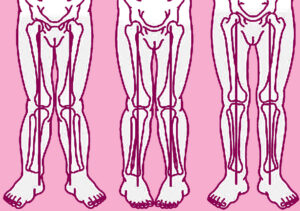
Causes of knock-knee :
Injury : Damaged to knees in an accident can cause knock-knees
- Faulty standing posture : Prolong standing in bad posture in daily activities.
- Rickets : It is common that can lead to knock knees
- Obesity : Overbody weight due to poor diet cause extra damaged to knees.
- Weakness of muscles and ligaments of knee region due to malnutrition.
- Wearing improper shoes : Can be caused by an modern fashion culture or by wearing heels for a prolonged period of time.
- Carrying heavy weight at early age
- Deficiency of vitamin-D, calcium and phosphorus.
Arthritis in the knee at old age is a frequent phenomena.
Precautions : (generally precautions are often the opposite of causes)
Baby shouldn’t be made to walk too soon. Children should have a balanced diet. Always wear high-quality footwear. In childhood, don’t carry around a heavy weight.
Corrective measures for knock-knee :
- Horse riding
- performing Padmasana and Gomukhasana regularlycan help strengthen muscles of the legs and realign the knees.
- Keeping pillow between the knee while standing puts extra pressure on misaligned knees outward.
- Use of walking calipersis big help at pre-puberty stage
- Walking along a straight line with knee facing outwards at least 10 minutes a day until it pains.
- Side kicking in football helps in knee alignment
- Supplements as advised by doctor.
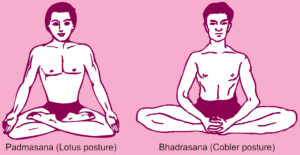
2.2.2 Flat Foot
It is a deformity in the feet. There is no arch in the foot and the foot is completely flat which may cause pain in the foot.
An individual with this deformity faces problem in standing, walking, jumping and running.
It is also known as pesplanus or fallen arches. It is a condition that may be diagnosed by examining the arch of the foot or performing the water print test. As the name implies, persons with flat feet have either no arch or an extremely low arch in their feet, enabling the whole soles of their feet to contact the floor when standing.
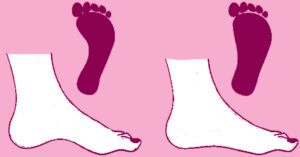
Cause of flat-foot :
- It may be genetic or environmental
- A foot or ankle injury
- Weak muscles
- Obesity due to over weight
- Improper foot wear (tight shoes, high heels etc.)
- Carrying heavy weight for long time
- Forcing child to stand up at very early stage. Normal Foot Flat Foot
Diseases like arthritis or rheumatoid may cause flat feet
Tarsal coalition is a syndrome in which the bones of the foot fuse abnormally, resulting in rigid and flat feet. Calf muscle tightness can cause temporary flat feet.
Precautions : (generally precautions are often the opposite of causes)
- Baby shouldn’t be made to walk too soon.
- Children should have a balanced diet.
- Always wear high-quality footwear.
- In childhood, don’t carry around a heavy weight.
Corrective measures for flat-foot :
- Walking on heels
- Walking on toes
- Rope skipping
- Jumping on toesin all four directions
- Perform yoga asanas like Adhomukh-savasanaduring Surya Namaskar,Vajrasana, Tadaasanaalso helpful in developing the arch.
- Picking pebbles by toes
- Running on inclined plane/stairs
- Cycling
- Stand up and down on heels
- Walking on inner and outer side of foot
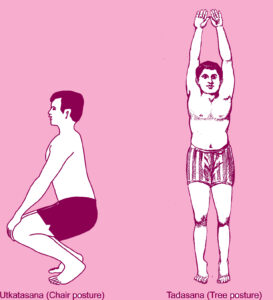
The purpose of having arches in the feet
- Arches gives a spring to the step and helps in evenly distributing the weight of the body between the feet and legs.
- The way a person walks is determined by the shape of the arches.
- In order to adjust to stress and a range of surfaces, arches need to be both strong and flexible.
- People’s posture while standing, walking, jogging, and other associated activities are all impacted by having flat feet.
- Ankle and knee issues can occasionally be attributed to flat feet.
2.2.4 Round Shoulder
It is the postural deformity in which shoulders are projected forward. In this deformity the shoulders become round and sometimes they seem bent forward.
It causes postural abnormalities like hyperkyphosis, often known as a hunched back and forward head position, to occur. These postural issues can worsen over time and result in additional diseases such thoracic outlet syndrome, shoulder immobility, and persistent neck discomfort.
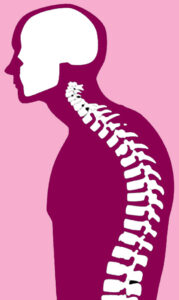
Cause of Round shoulder :
- Poor posture habits include lengthy periods of sitting, driving, and using a smartphone, tablet, or computer.
- heredity
- muscle imbalance
- tight fitting clothes
- injury in shoulder
- disease
- Faulty furniture
- Lack of physical exercise
- Carrying heavy loads on shoulders
Precautions : (generally precautions are often the opposite of causes)
- Baby shouldn’t be made to walk too soon.
- Children should have a balanced diet.
- Always wear high-quality footwear.
- In childhood, don’t carry around a heavy weight.
Corrective exercises :
(1) Perform yogic asanas such as Dhanurasana, Bhujangasana, Chakrasana and Ushtrasana.
(2) Backward bending exercises.
(3) Shoulder rotation.
(4) Sit on chair and stretch both hands backward, hold each other behind your back.
(5) Keep your tips of fingers on your shoulder and encircle your elbow clockwise and anticlockwise direction for same number of times.
(6) Pull the shoulders backward and see upward.
(7) Hold the hanging position on horizontal bar for sometime
(8) Performing chest stretches, T stretches, wall stretches, Handclasp stretches, planks, pull-ups, reverse shoulder stretches, and other exercises may help in strengthening and stretching of muscles.
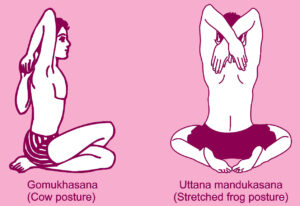
Spinal curvature deformities :
- Deformity is related to spine.
- Weak muscles cause the formation of spine curvature.
- Three types : 1 Kyphosis, 2. Lordosis, 3. Scoliosis
2.2.5 Kyphosis
Kyphosis implies an increase of a backward posterior curve or a decrease of a forward curve. It is also called round upper back or Hunch Back. Depression of chest is common in Kyphosis.
It is a spinal ailment where the curvature of the upper back increases. It has an excessively forward-rounded back.
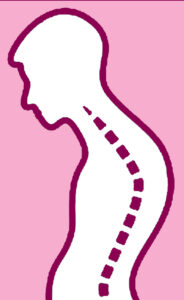
Cause of Kyphosis :
- Heredity or by birth
- Due to ageing, older women have weaker spinal bones, which can compress or crack.
- Disease like arthritis, osteoporosis commonly lead to
- Malnutrition or obesity
- Pulling of heavy weight over a long period of time
- Use of unstable furniture on daily basis.
- poor postural habit
- weakness in muscles due to lack of exercise
Precautions : (generally precautions are often the opposite of causes)
- Baby shouldn’t be made to walk too soon.
- Children should have a balanced diet.
- Always wear high-quality footwear.
- In childhood, don’t carry around a heavy weight.
Corrective exercises :
- Physical therapy in supervision of a physician
- Swimming twice a week help in improving this condition.
- exercise/gym ball exercises which help to strengthen back muscles
- Daily exercises with bands
- Yoga asanas like Dhanurasana, Chakrasana and Bhujangasana should be performed to get optimum benefits
- Using a flat bed with a thin pillow while sleeping is also helpful.
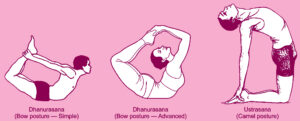
2.2.6 Lordosis
Lordosis is a postural deformity of the spine. In this deformity, the spine curvature is increased inward in the lumbar region.
- Lordosis is derived from the Greek word lordos, which means to bend backward.
- The neck, upper back, and lower back of the spine all have slight curvature.
- These curves, which form the S shape of the spine, are known as the kyphotic (upper back) and lordotic (neck and lower back).
- A spinal abnormality called lordosis causes the lower back’s arc to be lessened. This causes the natural concavity of the lumber area of the spine to grow and become more pronounced. It’s also referred to as sway back.
- If neglected, chronic Lordosis can cause pain and suffering as well as worsen.
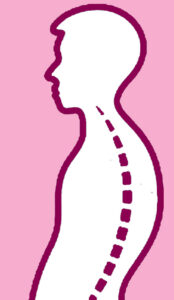
Cause of lordosis :
Precautions :
Corrective exercises :
Add by Author
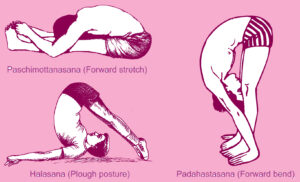
2.2.7 Scoliosis
Explain Scolosis
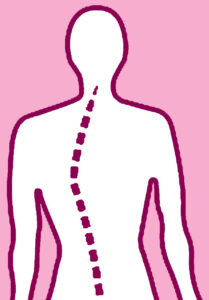
Cause of Scoliosis :
- Injury of the bones and joints
- Carrying/lifting heavy loads
- Heredity
- Weakening of spinal muscle in one side
- Due to infantile paralysis, rickets or weakness of the muscles
- Heavy load on shoulder
- Due to some diseases or injuries such as cerebral palsy
- Due to poor light
- Faulty posture like wrong habit of sitting
- Partial deafness
- May be congenital or acquired abnormalities of vertebras
Precautions : (generally precautions are often the opposite of causes)
- Baby shouldn’t be made to walk too soon.
- Children should have a balanced diet.
- Always wear high-quality footwear.
- In childhood, don’t carry around a heavy weight.
Corrective measures for scoliosis :
- Breast stroke in swimming of at least 10 minutes helps in recovery.
- Pull-ups/Hanging on Horizontal Bar puts strain on the back.
- Banding exercise on the opposite side of ‘C’ curve
- Flexion, extension, side ward flexion of the spine
In severe cases, children, teenagers, or the person may need to wear braces or possibly undergo surgery. Yoga Trikonasana and Adhomukhasana should be performed to straighten the spine.
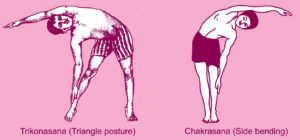
2.2.8 Bow Legs
When the feet and ankles are in contact and the legs curl outward at the knees, the position is known as ‘Bow Legs.’ Bow legs are common in babies and young children. Bow Legs is another name for Genu varum.
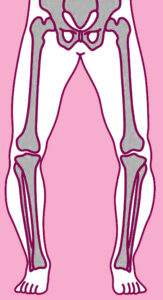
Causes of Bow Legs :
- Due to lack of Vitamin D, Phosphorus and Calcium and can be easily cured at an early stage.
- Using uneasy footwear for long period.
- Forcing a child to walk at a young age
- Children with bow legs may walk with pigeon toes, which are pointed inward, or they may trip frequently and seem awkward.
- Diseases such as Blount’s disease, rickets, or arthritis in the knees and hips
- Deficiency of vitamin D and calcium
Precautions :
- Baby shouldn’t be made to walk too soon.
- Children should have a balanced diet.
- Always wear high-quality footwear.
- In childhood, don’t carry around a heavy weight.
Corrective measures Bow Legs :
- Use of braces and wearing shoes with modifications.
- A balanced diet that is consumed in adequate amounts proves to be beneficial.
- It could also be beneficial to walk on the inside of your feet.
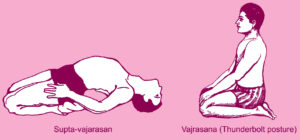
2.3 Women Participation in Sports : Physical, Psychological and Social benefits
Sports Women in India
Many Indian women have upheld Indian flag at the world level. P.T. Usha came fourth in 1984, Los Angeles Olympics. Anju Bobby George grabbed the limelight when she won the bronze medal at the 2003 World Championships in Athletics in Paris. Five time world champion, MC Mary Kom made India proud by winning the bronze medal at the London Olympics, 2012. SainaNehwal has brought glory to India. She is the first Indian to win a bronze medal in Badminton at that Olympics. At 21 years ,SaniaMirza was ranked 29th on the Women’s Tennis Association (WTA). Indian women cricket team won the Women’s Asian Cup from 2004 to 2006 and came second in Women’s cricket World Cup in 2005.
Some of the Problems Faced by Woman Athlete in India :
- Restrictions and lack of encouragement by the society and parents
- Lower pay compared to male athletes.
- Security issues when woman teams are travelling to different places for competitions
- Lack of good woman coaches
- Social morality
- Women are considered weak
- Sponsorship problems. Very less sponsors for promoting women’s competitions and sports women
- Old fashioned customs, practices, tradition followed mostly in rural India like girls should use cloths to whole body parts, they should be married early etc.
- Domestic issues (marriage etc)
- Lack of media coverage for woman competitions.
Recent development taken to encourage female athletes
- To address these disparities, several female athletes have taken part in nonviolent protests including playing strikes, social media campaigns, and even legal actions.
- The International Olympic Committee (IOC) promotes engagement in sport among women administrators, coaches, technical officials, and journalists in addition to encouraging them to join National Olympic Committees and International Federations and participate in regional seminars.
- According to a recent IOC declaration, 49% of women will compete in the next Olympic games.
- The Indian Constitution guarantees gender equality and the abolition of all forms of discrimination or barriers based on gender.
- Women’s empowerment and gender equity may be achieved via sports.
Suggestions for More Participation of Woman in Sports in India :
- Sports Authority of India should take a more active role in women sport.
- Sponsors should come forward with more support.
Women participation in sports helps them to stay fit and reduces chances of diseases.
- Hostel and other infrastructure facilities need to be improved.
- More special sport training centers for women should be set up.
- More number for female-trained coaches.
- Selection procedures should be fair and transparent.
- More scholarships should be provided for women sport persons so that they stay longer in their sport.
- There is a need to promote and encourage sport at school level.
- Symposiums and workshops should be held to bring in more awareness among the society about sports.
I. Physical Benefits
- Lifestyle Diseases : Participating in sports encourages women to maintain an active lifestyle, which lowers their risk of developing lifestyle illnesses like diabetes, high blood pressure, obesity, etc. and helps them lead healthy lives.
- Bone Density : Females are more likely than males to get osteoporosis. They benefit from sports by developing stronger and denser bones.
- Toned Muscles : Women benefit from increased muscular tone due to regular exercise and involvement in sports since it keeps them strong.
- Cardiovascular System : Regular exercise increases the number of capillaries, which increases in oxygen absorption. This makes it possible for women to engage in sports for extended periods of time without getting fatigued.
- Obesity : Women are more likely than males to be overweight, although frequent athletic engagement helps them maintain their fitness levels.
II. Psychological Benefits
- Stress Management : Any physical exercise causes our bodies to generate a variety of chemicals that keep us content and lower our stress levels, allowing athletes to better control their stress.
- Control Emotions : Female athletes are well-equipped to control their emotions since they are subjected to stressful conditions on the field, and regular participation makes them emotionally stronger.
- Confidence : Every modest victory boosts the winner’s confidence. Thus, when a woman engages in athletics and succeeds, it offers not just her but also other female athletes a sense of accomplishment and enhances their confidence.
- Self-Esteem : Women that win in sports or even just engage in them have an increase in their self-image, which helps them in realising their own value, which is crucial for an individual.
- Leadership : One of the best things about athletics is that it develops or brings out a person’s leadership abilities. Women and men who are better at participating in sports are also better at leading others outside of sports.
III. Social Benefits
- Coordination : Women who participate in sports gain the skill of working in coordination with others, and sport helps to increase and improve teamwork among participants.
- Communication : Sports require participants to speak with one another while playing, hence communication is an essential component of sports. It encourages female participants to stand out and express themselves more.
- Inter-relationships : When playing a team sport, a player must establish relationships with everyone on the team, whether they be teammates or supporting staff. Female participants are taught to appreciate and preserve their relationships both on and off the field.
- Cooperation : When doing sports, women develop their ability to work cooperatively. As they learn to cooperate and collaborate with others in complete harmony and peace, this also becomes a part of their daily lives.
Important Terms : ———————————————————-
- Emotions : • Emotions are feelings which result in physical and psychological changes that influence our behaviour.
- Emotions are strong feelings deriving from one’s circumstances, moods or relationship with others. (Any one)
- leadership : • Leadership may be defined as the quality of the person to lead others or direct others.
- In India, women’s engagement in sports and activities should be encouraged.
(i) Self confidence must be developed in women.
(ii) Female role model to be highlighted.
(iii) More time and facilities to be given to women participation.
(iv) Women should be aware regarding the benefits of sports. (Job opportunities, Personality development etc.)
(v) Better safety measures to be implemented.
(vi) Legislation regarding women in sports should be more flexible.
(vii) Attitude of spectators and media should be motivating.
(viii) Women coaches should be appointed in more number.
(ix) Equal importance to be given to female in sports.
————————————————————————————–
Participation of Indian women in sports :
Sports in India is still dominated by the male world. It is a field where gender inequality still persists. India is a country of villages where education is still at backdrop.
With changing times in the 20th century some states have made rapid progress in women participation but the other states still let back due to various reasons.
(1) Social discrimination : Women are still exploited to be confined in homes, cook, rear the children in family.
(2) Lack of safety : Outdoor sport expose women to all sorts of safety issues. On field, roads or on public transport women always feel unsafe. Lack of protected and safe sports complexes also raise issues and add to their misery. This provides a good reason to the parents to discourage them for participation.
(3) Poor spectator interest : As media coverage of female events is not adequate, people are less interested in seeing the events.
(4) Lack of adequate fitness : Women get little opportunity of being physically fit and active due to major responsibilities of home and family. Inadequate healthy and nutritious food availability takes a toll on their health.
(5) Lack awareness in families : Families are not aware about sports and woman participation and discourage women to pursue sport. This is because they feel that it is not a rewarding career. They feel that sports develop masculine traits and the women will have difficulty in conception and child birth.
(6) Lack of women centric govt. policies : Funding and scholarship are lesser. Recent improvement in woman participation and results at international platform is however changing the thought perceptions.
2.4 Special Consideration (Menarche & Menstrual Dysfunction)
2.4.1 Menarche
Menarche is the process in which female reproduction system matures and the body prepares itself for potential pregnancy. It is associated with the development of secondary sexual characteristics. Menarche is the first menstruation and the commencement of cyclic menstrual function in female. It usually occurs between 8 to 15 years of age. Menarche is one of the most significant milestones in a woman’s life.
Menarcheal age is caused by genetic effects, socioeconomic situations, overall health and well-being, nutritional status, certain forms of exercise, seasonality, and family size.
2.4.2 Menstrual Dysfunction
Menstrual dysfunction means the irregularity and uncertainty in menstrual cycle of women.
A disorder or irregularity in a woman’s menstrual cycle is known as menstrual dysfunction. The menstrual cycle typically lasts between 21 and 35 days. When it occurs before 21 days or beyond 35 days, there is a concern. Missing three or more periods, higher or lighter than usual menstrual flow, cycles lasting more than seven days, any discomfort, cramps, or vomiting during period, bleeding beyond menopause, etc. are symptoms of other menstrual disorders.
Effect on sports participation :
- Athletic training and exercise neither affect the menarche nor menstrual periods.
- Heavy and intense training program may result in amenorrhea.
- Exercise is beneficial in relieving pain (dysmenorrhea).
- Sometimes strength decreases during menstrual cycle and affects the performance.
- Less hemoglobin affected oxygen intake, hence sports performance is affected.
- Uncertainty in menstrual cycle may cause stress and anxiety.
Various menstruation disorders :
- Pre-menstrual Syndrome : Premenstrual Syndrome refers to unpleasant or uncomfortable symptoms that occur throughout the menstrual cycle. These might continue for a few hours to a few days and include things like sadness, anxiety, irritability, headaches, fainting, vertigo, infections, etc. Through moderate exercise, a balanced diet, getting enough sleep, and rest, these symptoms may be lessened.
- Amenorrhea : Amenorrhea is a menstrual disorder in women, (a), where girls of 18 years and above either never began menstruating or, (b), there is an absence of menstruation for three months or more than that in woman with a history of normal menstrual cycle.
- Dysmenorrhea : Dysmenorrhea happens when menstruation causes significant discomfort or frequent menstrual cramps. Dysmenorrheal symptoms might include cramping in the lower abdomen, low back pain, leg discomfort, nausea, exhaustion, weakness, etc.
- Menorrhagia : Menorrhagia is a condition that causes excessive, prolonged, or continuous menstrual flow.
- Polymenorrhea : A menstrual cycle that last for less than 21 days is referred to as polymenorrhea.
- Oligomenorrhea : Oligomenorrhea is a condition which causes irregular menstruation with periods spaced more than 35 days apart.
- Metrorrhagia : Missed, delayed, irregular menstrual cycles or unusual bleeding patterns are referred to as metrorrhagia.
- Postmenopausal bleeding : Bleeding that occurs after a year of menopause or after a woman has stopped menstruating as a result of menopause is known as postmenopausal bleeding.
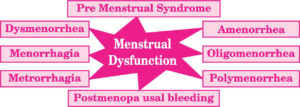
2.5 Female Athlete Triad :
(Osteoporosis, Amenorrhoea, Eating Disorders)
The Female Athlete Triad is a syndrome (collection of signs and symptoms) that links three health problems including : disordered eating, amenorrhea and osteoporosis. Girls may begin to skip periods if they are not getting adequate nutrition for the amount of exercise they do (energy availability). Periods also may be irregular. Stress lowers estrogen levels, which may cause skipped periods. Low estrogen levels and a lack of menstrual periods can lead to low bone mass (low bone mineral density) and stress fractures (small cracks) in their bones. The female athlete triad is defined as the combination of disordered eating, amenorrhea and osteoporosis. This disorder often goes unrecognised. The consequences of lost bone mineral density can be devastating for the female athlete. Premature osteoporotic fractures can occur, and lost bone mineral density may never be regained.

2.5.1 Osteoporosis
Low estrogen levels and poor nutrition, especially low calcium intake makes bone porous. Osteoporosis is a weakening of the bones due to the loss of bone density and improper bone formation.

Symptoms of osteoporosis :
- Bone injury is common due to weak bones.
- Loss of height over time.
- Acurved, stooped posture.
- Frequent lower back pain
- Due to weak bones the spine has a curved, stooped shape.
- Deposition of bone increases during childhood and adolescence and peaks during the 20s and 30s
Causes of osteoporosis :
- Calcium and Vitamin-D deficiency: Due to poor diet causes insufficient amount of calcium and vitamin-d which leads to osteoporosis
- Amenorrhoea: female athletes suffering from amenorrhoea for long duration may lead to osteoporosis.
- Sedentary life style
- Side effects of medication
- Thyroid condition:
- Due to the menstrual dysfunctioning in women
- Eating disorders like anorexia bulimia/poor nutrition
Prevention of osteoporosis :
- Understanding family history or other medical conditions associated with bone mineral density (BMD) may assist female athletes avoid injury and fractures.
- Maintain energy imbalance: The key intervention is to modify energy consumption and energy availability.
- The primary therapy is the restoration of a regular menstrual cycle in order to reestablish energy balance and increase bone mineral density.
- Family-based therapy and behavioral therapy are also helpful treatments for disordered eating.
- A sports nutritionist may assist the athlete and her family in determining the quantity and quality of food consumption and dietary supplements needed to satisfy her body functions, replenish energy output due to athletic training, and improve bone health.
2.5.2 Amenorrhea
Amenorrhea is a menstrual disorder in women where girls of 18 years and above either never began menstruating or there is an absence of menstruation for three months or more than that in woman with a history of normal menstrual cycle.
Primary Amenorrhea is when a girl above age of 18 years who has not begun menstruating.
Secondary Amenorrhea occurs when unnatural absence of menstrual cycle for more them three months.The absence of menstruation/menstrual periods in a woman for more than three months.
Causes of Amenorrhea :
Add by author.
2.5.3 Eating Disorder
An eating disorder is defined by a severe alteration in eating behaviour and involves a wide range of harmful and often ineffective eating behaviours in the process of weight reduction
Types of eating disorders :
- Anorexia nervosa is an eating disorder in which a person attempts to decrease body weight unnaturally while experiencing a severe anxiety of putting on weight or having an incorrect perception about their weight.
Anorexic individuals put a great priority on maintaining their weight and form, making excessive attempts that frequently seriously disrupt their lives. People with anorexia typically drastically restrict their food intake in order to avoid gaining weight or to keep losing weight. By vomiting right after eating, or by misusing laxatives, diet supplements, or diuretics, they can reduce their caloric intake. They could also make an effort to reduce weight by overtraining themselves. No matter how much weight is removed, the person’s anxiety of weight gain never goes away.
Symptoms of Anorexia nervosa
- menstrual dysfunction
- constipation
- diarrhea
- bloating
- unexpected weight loss
- muscle weakness
- stress fracture
- bone weakness
- overuse injuries
- anxiety
Prevention :
(i) Encourage a healthy view of the self and others means refraining from commenting on the body sizes of other children.
(ii) Make children aware about their genetics, body shape and size.
(iii) Make them to eat healthy, nutritious food and be physically active.
(iv) Stay away from the people, places and activities which induce anorexia.
Management :
(i) Face the reality.
(ii) Restoring healthy weight.
(iii) Individual psychotherapy.
(iv) Antidepressants to aid the process of recovery.
- Bulimia nervosa is eating disorder in which a person (adolescent girl/young women) eats excessive amount of food and vomits it out in order not to gain weight. A person suffering from this disorder feels loss of control on oneself. Does not eat proper food and hence lack proper nutrients.
It is normally of two types :
(1) Purging : When the person self induces vomiting.
(2) Non-purging : When the person uses severe fasting, rigid dieting or excessive exercising to reduce weight.
Causes :
(1) Pressure of performance in sports (e.g., Gymnastics, Marathons etc.)
(2) Social factors
(3) Maintain weight category in sports
(4) Genetic factor
(5) Psychological factors (e.g., A person with low self-esteem)
Symptoms of bulimia are
- Dehydration
- dental problems
- oedema
- electrolyte abnormalities
- extreme weight fluctuation
- menstrual irregularity
- weakness
- cramps
- depression
Prevention :
(i) Encourage a healthy view of the self and others means refraining from commenting on the body sizes of other children.
(ii) Make children aware about their genetics, body shape and size.
(iii) Make them to eat healthy, nutritious food and be physically active.
(iv) Stay away from the people, places and activities which induce bulimia.
Management :
(i) Antidepressants to help in the healing process.
(ii) Accept the truth.
(iii) gaining a healthy weight again.
(iv) individual psychotherapy.
